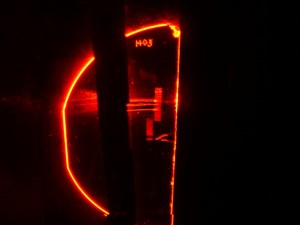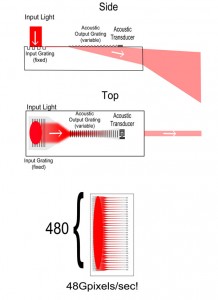Progress in Guided-wave Devices for Holographic Video Display
- Category: Electronic Devices
- Tags: V. Michael Bove
We seek to fabricate massively parallel waveguide lithium niobate spatial light modulators as an enabling technology for the next generation of large holographic video displays. Holo-video displays based on acousto-optic (AO) modulators currently use 20 channels or fewer per AO device. We are fabricating devices with 480 channels on a single substrate with each channel modulating light at 50 MHz bandwidth for a total of 48 Gpixels/sec of modulation, which is sufficient for VGA resolution, horizontal-parallax-only displays of one meter or more in width.
- Figure 1: A device undergoing testing.
- Figure 2: Diagram of our device.
- C. S. Tsai, Q. Li, and C. L. Chang, “Guided-wave two-dimensional acousto-optic scanner using proton-exchanged lithium niobate waveguide,” Fiber and Integrated Optics, vol. 17, pp. 57-166, 1998.
- D. Smalley, “High-resolution spatial light modulation for holographic video,” Master’s thesis, Massachusetts Institute of Technology, Cambridge, 2008.
- D. E. Smalley, Q. Y. J. Smithwick, and V. M. Bove, Jr., “Holographic video display based on guided-wave acousto-optic devices,” in Proc. SPIE Practical Holography XXI, vol. 6488, p. 64880L, 2007.
- Q. Y. J. Smithwick, J. Barabas, D. E. Smalley, and V. M. Bove, Jr., “Real-time shader rendering of holographic stereograms,” in Proc. SPIE Practical Holography XXIII, vol. 7233, p. 723302, 2009.

